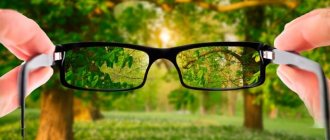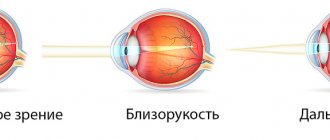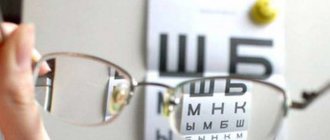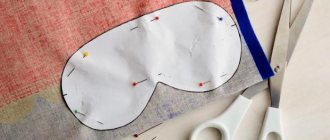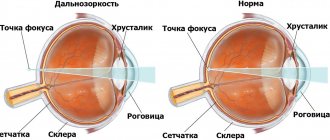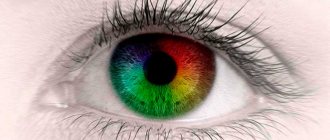Before diagnosing any problem in the body, you should analyze its condition. In some cases, you need to undergo a series of tests and take other measures, but in the field of ophthalmology, primary diagnosis is much simpler.
Every person has encountered vision tests at least once during a medical examination. You can arrange such a check not only in the ophthalmologist’s office, but also in your own home.
Before you do any of the tests, remember what vision problems you have encountered. Do you suspect farsightedness, nearsightedness or astigmatism? Choose the appropriate test. And do not forget that the test should be carried out when you are feeling well.
Vision test. Eye test at home
Duochrome test
An online vision test on a computer has proven itself quite well - this is a duochrome test to determine myopia (myopia) or farsightedness (hyperopia). This test helps determine the refractive power of the optical apparatus of the eye, which is measured in diopters and is briefly called “eye refraction”. Many people know that colors have different wavelengths, due to which, when entering the pupil, green waves of light are focused closer to the cornea than red ones. If you have good vision (emmetropia), then for you the letters in the green field will be like for people with myopia, and in the red - like for people with hypermetropia.
Presbyopia
One of the most common causes of acquired hypermetropia is age-related changes. The key factor in the development of farsightedness in the elderly is disruption of the functioning and structure of the eye lens. Normally, it is a lens of a biconvex configuration located behind the cornea. The structure of the lens is transparent, surrounded by a capsule to which the ligaments that hold it are attached. The latter, in turn, regulate the refractive power of the element. With age-related farsightedness, this refractive ability of the eye is impaired. Therefore, problems arise with viewing closely located objects. Presbyopia develops after the age of forty. Only an ophthalmologist in a clinical setting can correctly determine age-related farsightedness and the degree of its severity. However, you can draw conclusions about the presence of this disease yourself.
Astigmatism test
In addition to such refractive errors of the eye as myopia (myopia) and farsightedness (hyperopia), astigmatism can also be distinguished. If myopia and farsightedness are more or less clear, then how can you check your vision at home for the presence of astigmatism? For this there is an online test “Siemens Star”. Online vision diagnostics can also be carried out using a monitor with brightness at maximum value, in the first half of the day and in good health without glasses or lenses. Normally, the cornea and the anterior surface of the lens are spherical; if the shape of the sphere is disturbed, then we are dealing with astigmatism, which can be identified at an appointment with an ophthalmologist, as well as with the help of a Siemens star - a drawing depicting lines that converge in the center (black rays on white background). The diameter of the circle with rays is ten centimeters. With astigmatism, the image of the star is greatly distorted, the black stripes at the edges may visually thicken, or change the contrast or shape; a gray ellipse, shapeless striped figures or an oval may appear in the middle of the circle.
Types of farsightedness
According to clinical manifestations, there are several types of hypermetropia:
- Explicit - preservation of accommodation with a normally functioning lens.
- Complete - a comprehensive manifestation of the disease with a non-functioning accommodation apparatus.
- Hidden - the difference between obvious and complete farsightedness is directly displayed in diopters. Shows the compensatory characteristics of the lens.
Differences between individual types of pathology are identified by a doctor during a medical examination.
Color vision test
It happens that parents begin to notice oddities in the child’s behavior regarding color perception, or an adult realizes that he does not see all colors. In such cases, you can quickly and at home check your vision thanks to special pictures called “Rabkin tables”. A picture with a number inside a circle. The number is depicted thanks to many small circles inside the main circle, and these circles, in fact, form this number. People without color vision impairments see these numbers; if a person has color vision, for example, color blindness, the person cannot determine the necessary numbers.
Snellen chart
Another type of visual acuity testing is the Snellen chart. This pattern contains rows of letters, called optotypes, that decrease in size from row to row from top to bottom. At a distance of sixty meters, a person with good eyesight can easily read the top lines. But to test your vision yourself, you will need only 6 meters between you and the image. A person with good vision can freely read one of the bottom lines with each eye separately. And the bottom lines (there is already small text there) are already used to test near vision.
Treatment
To correct vision for presbyopia, lenses or glasses are used. If a person has not previously had any special vision problems, then only reading glasses will be needed.
If you have previously used glasses, you should check your vision again and change them. Bifocal glasses are convenient, the lenses of which are made up of two parts: the upper one, intended for distance vision, and the lower one, for near vision.
There are now both trifocal glasses and comfortable contact lenses that can create a smooth transition from far to intermediate and near vision.
Surgical treatment methods include laser keratomileusis and photorefractive keratectomy. These methods rely on the use of a laser to change the shape of the cornea. Thanks to this, one eye is “tuned” to work near, and the other can quite accurately see distant objects.
This artificially formed vision is called monocular. Another surgical method for treating presbyopia is implantation of an artificial lens.
To date, a set of exercises for eyes with presbyopia has been developed. Regular exercises can stop the decline in vision, and sometimes even restore it. The complex is based on the principle of relaxation. It is very important to “teach your eyes” to relax.
To do this, you need to regularly perform the exercise with a wristwatch and an alarm clock and read alternately with one or the other eye. To treat presbyopia, yogis recommend looking at the sun at sunrise and sunset.
It is useful to relax the eyes to look at the blue sky, clouds, horizon line, green forest.
Disease prevention
If the first signs of presbyopia appear, it is important to follow these simple recommendations:
- Breathe rhythmically and deeply when performing work close to the eyes.
- Relax your eyelids as much as possible when reading, blinking frequently but slowly.
- Eye hydration should be adequate; you can use special “Natural Tear” drops.
- Perform a simple exercise regularly: alternately look at objects, either close or far away.
It is also useful to take vitamins and special medications that have a beneficial effect on the organ of vision, for example, Aevit, Blueberry Forte with lutein, Ascorutin and others.
Watch an interesting video on the topic of the article with a famous presenter:
RORBA table
The RORBA tables are named after several of its authors, namely Rosenbaum, Ovechkin, Roslyakov, Bershansky, Aizenshtat. The main difference between these tables is that they have optotypes for determining vision with an indicator of 0.05, as well as a uniform change in the size of the picture from line to line with a coefficient of 1.26 (but the first three are an exception, since they are for the visually impaired) and, most importantly, the number of characters in a line is eleven, and this interferes with easy memorization. The signs can be either letters or Landolt rings.
Misdiagnosis of farsightedness
Quite often situations arise when the diagnosis of “farsightedness” is made incorrectly. For example, this can happen when examining small patients. Often, an incorrect diagnosis is made to children aged one year, during a routine preventive examination. This is due to certain factors, including difficulties during the ophthalmological examination. However, the use of modern diagnostic techniques minimizes the possibility of errors when checking eye health. Ophthalmological equipment today makes it possible to determine the type and severity of refractive pathology with a high degree of accuracy. Examination under conditions of medically induced cycloplegia (controlled paralysis of the ciliary muscle) with a dilated pupil helps to reduce the likelihood of making an incorrect diagnosis in young patients and children, as well as to identify a hidden variant of the course of the disease. Mydriasis is achieved by instilling the drug Atropine into the eyes.
In addition, it is important to carry out gonioscopy, biomicroscopy, tonometry and other measures to identify related ophthalmological problems.
Bailey-Lovey table
Ophthalmology has a wide variety of ways to obtain visual acuity test results on a monitor, among them, and offers different ways to calculate the results. If in the Sivtsev-Golovin tables calculations are carried out based on the principle of arithmetic progression and measure changes in the sizes of letters (rings), then the Bailey-Lovey system suggests using a geometric progression of changes in the size of optotypes with a denominator of 1.26 and the interval between letters in a line depends on the width of the letter, and The spacing between lines depends on the height of the letters.
How often should you have your eyes checked?
Very approximate results if you check at home on a computer online, or on printed tables. However, you can only check your eyesight correctly together with a specialist. Your vision can be assessed at home at any time, but it is advisable to visit an ophthalmologist at least once a year. If pathologies are detected, the ophthalmologist will prescribe timely treatment or prevention of eye diseases. The doctor can also explain how training should be carried out correctly to maintain visual acuity.
What are the reasons
Age-related farsightedness is a natural process of aging of the body, so there are no specific, direct causes. We will consider not the causes of presbyopia, but different options for its development:
- Age. The eye, like everything else in the body, wears out: various diseases, harmful radiation, operations, injuries (up to changes in the normal anatomy of the eyeball), infections, etc. contribute to structural changes in the visual apparatus. The muscles responsible for accommodation stretch, lose elasticity, weaken, and undergo dystrophy. The lens itself also loses its elasticity, thickens, becomes cloudy, which sooner or later will lead to the muscles weakening, and without refraction we will not see anything.
- Farsightedness, myopia, development of cataracts, glaucoma. These pathologies contribute to the development of presbyopia, since in the case of these diseases the optical system of the eye suffers, and the structure itself also changes and is disrupted.
- Systemic diseases of the body. This refers to diseases such as diabetes mellitus, vascular atherosclerosis, hypertension and other diseases that contribute to the disruption of ocular circulation and nutrition of the eye.
- Bad habits. Smoking, alcoholism, drug use, and metabolic disorders will definitely not improve your health, and due to the narrowing of blood vessels, they will disrupt the trophism of the visual apparatus.
- Poor nutrition, neglect of visual regime. Excessive eye strain, lack of vitamins and minerals, failure to comply with lighting rules and eye hygiene often lead to vision complications and early development of presbyopia.

